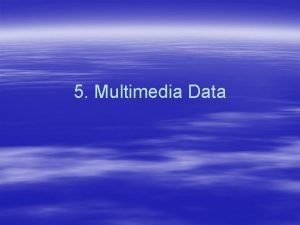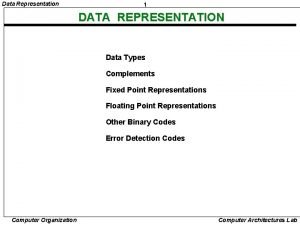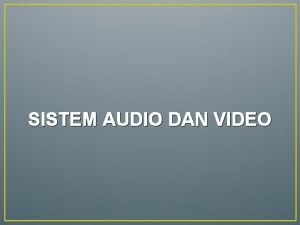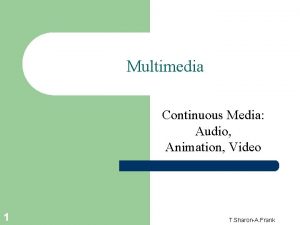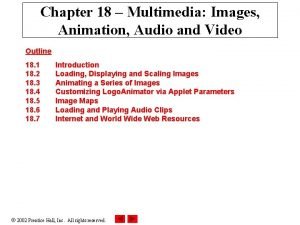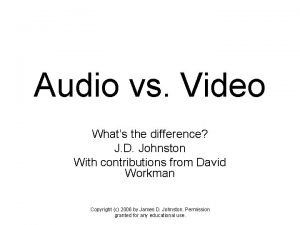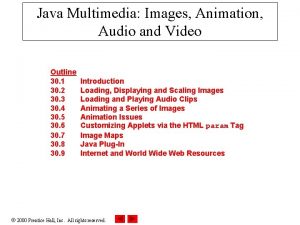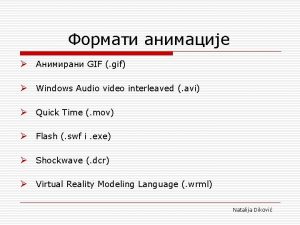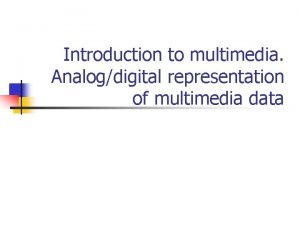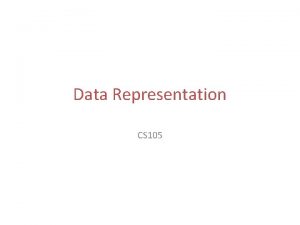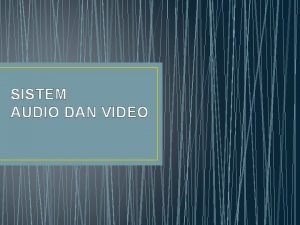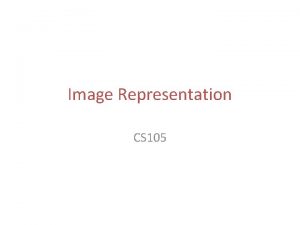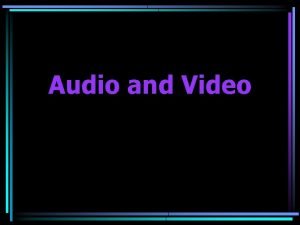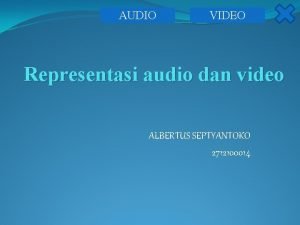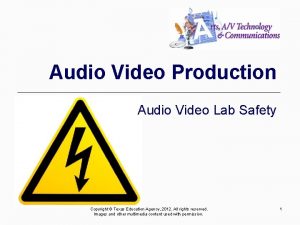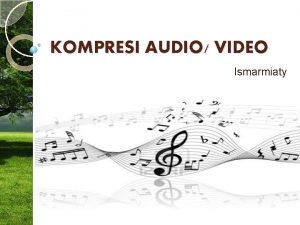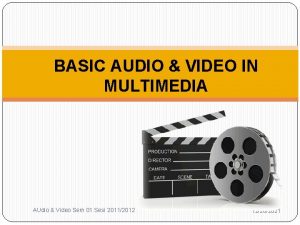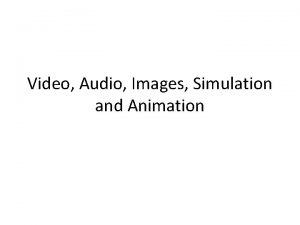Audio Video Representation CS 105 Data Representation Types













- Slides: 13

Audio & Video Representation CS 105

Data Representation • Types of data: – Numbers – Text – Images – Audio & Video

What is sound? • A continuous wave created by oscillations of pressure through any material (solid, liquid & gas) Analog signal • For a computer: Analog to Digital – Specialized Hardware

Digitizing Sound Quantization Voltage Sampling Time • Discrete time (sampling) & discrete voltage (quantization) • Reasonable sound production: 40, 000 times per sec • Quantization: Dividing vertical axis into pieces – process of mapping a continuous range of values by a small finite set of values • 8 bit quantization = 256 levels, 16 bit = 65536 levels

Digitizing Sound Quantization into levels Sampling time intervals How many bits are needed to represent per sample? - 3 bits - Power of 2 How many bits are needed to digitize this signal? - 3 x 13 = 39 bits

Bit Depth and Bit Rate • Bit Depth: Number of bits per sample • Bit Rate: Number of bits that are sent per unit of time q Each tick on the time axis (x-axis) is 1 sec. All levels are represented by 3 bits. What is the bit rate? - 3 bits/s 1 sec q Every 4 ticks on the time axis is 1 sec i. e. you sample 4 times a second. What is the bit rate now? - 12 bits/s

Audio Formats • Wav, AU, AIFF, VQF and MP 3 • MP 3 (MPEG 1 or 2) – dominant format for compressing audio data – Psychoacoustic models – Form of Huffman encoding – Lossy compression • Bit rates: – Uncompressed audio: 1411 kbit/s – Compressed audio (such as mp 3) : 128 to 320 kbit/s

Practice Digitizing Signals!

Name: Date: Voltage Level 4 Level 3 Level 2 Level 1 S 2 S 3 S 4 S 5 S 6 Digitize this graph in the sampling intervals using 2 bits Time

Video • Three dimensional array of color pixels – Succession of images – Each image in the video is called a frame • Video: Duration, Frame Size with a bit depth, frame rate (fps) – Example video: Duration: 3600 s (1 hr), Frame Size: 640 W*480 H with 24 bits for each pixel, 25 fps • Frame: 0. 0009216 Gb, Every sec: 0. 023 Gb, • Every hour: ~83 Gb – Human eye and frame rate: film and video games

Video Codecs • Video files are big! – Typically gigabytes of data for an hour of video • Codec: Compressor/Decompressor – Employs lossy compression – Temporal & Spatial compression • Temporal compression: Differences between frames – Keyframe is used to compare differences between frames and encode only the differences • Spatial compression: Similar regions within frames and groups them – Run length encoding

Container formats • Encapsulates both audio, video and metadata (needed to synchronize audio and video streams) • Stores the data, does not encode it – For access: program that opens the container and decodes the data inside • AVI, MOV

Video Data • MPEG 1, 2 and 4 lossy compression – MPEG 1 and 2 – deals with differences in frames – MPEG 4 : • Better video quality than MPEG 1 and 2 • Widely used • Instead of dealing with each individual frame, it tackles objects within each frame • Bit rate: – 1. 25 Mbit/s – VCD quality (MPEG-1 video compression) – 5 Mbit/s – DVD quality (MPEG-2 compression) – 8 to 15 Mbit/s – HDTV quality (MPEG-4 compression) – 40 Mbit/s max – Blu-ray Disc
 Multimedia data representation
Multimedia data representation Data types in data representation
Data types in data representation Audio dan video adalah
Audio dan video adalah Image is a continuous media.
Image is a continuous media. Audio web conferencing
Audio web conferencing Audio video interleaved
Audio video interleaved Animation audio video
Animation audio video Audio vs video
Audio vs video Audio untuk video pembelajaran
Audio untuk video pembelajaran Animation audio video
Animation audio video Natalija dikovic
Natalija dikovic Video representation in multimedia
Video representation in multimedia Yandex ru video search text video
Yandex ru video search text video Yahoo gravity
Yahoo gravity
